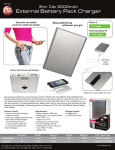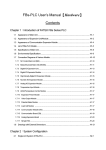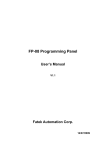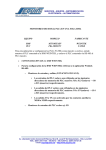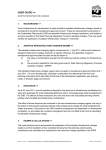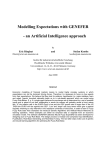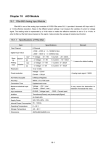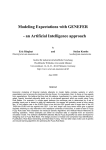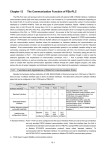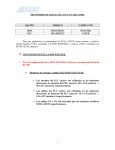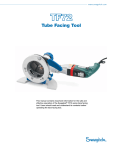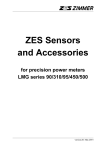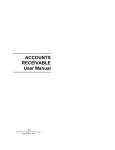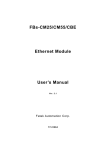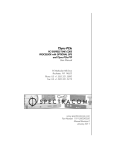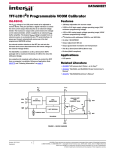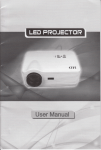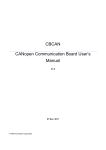Download Contents
Transcript
Preface, Contents 9 FBs-PLC Interrupt Function FBs-series Programmable Controller User’s Manual - II 【Advanced Application】 FBs-PLC High-Speed Counter and Timer 10 Communication of FBs-PLC 11 The Applications of FBs-PLC Communication Link 12 The NC Position Control of FBs-PLC 13 Application of ASCII Output Function 14 Real Time Clock ( RTC ) 15 FBs-7SG 7/16-Segment LED Display Module 16 FBs-32DGI Thumbwheel Switch Input Module 17 FBs-6AD Analog Input Module 18 FBs-4DA/2DA Analog Output Module 19 FBs-4A2D Analog Input/Output Module 20 Temperature Measurement of FBs-PLC and PID Control 21 General Purpose PID Control 22 Instruction List of FBs-PLC Appendix 1 FATEK Communication Protocol Appendix 2 FBs-PACK Operation Instruction Appendix 3 Attention related to safety (Read carefully before application) ◎ For the purpose of ensuring your personal safety and protecting this product and its peripheral equipment, read this manual regarding the safety functions carefully before installation and operation of the FBs PLC. The three safety categories of this manual are classified into 「Danger」, 「Warning」, 「Caution」grade according to the danger level and are preceded by the ““ symbol. Following is their description: Danger Indicates casualty or serious damage or property loss will result if the correct instruction was not followed. Warning Casualty or serious damage or property loss may result if the correct instruction was not followed. Caution Indicates minor damage or property loss will result if the correct instruction was not followed. ◎ This manual is a guideline for qualified personnel on how to install the FBs PLC correctly and use it safely. The qualified personnel stated here means professional electromechanical engineering personnel who is familiar with safety specifications and methods of grounding, circuit wiring, peripheral equipment system etc. and possesses practical experience. Danger ☉ Keep in mind before using the PLC Abnormality in the external power supply or failure of the PLC itself will result in the PLC or the complete system emerging in an unsafe status, and may cause unpredictable actions. Such actions may cause human injury, death, or serious damage of the unit itself. Thus, please design a separate external safety protection circuit, such as emergency stop circuit, machine replacement device, or redundant safety protection circuit in your application with the following safety considerations: 1. Emergency stop circuit, safety protection circuit, motor positive/reverse interlock circuit, upper/lower limit destruction prevention circuit of position control, etc. These circuits should be hardwired and external to the PLC. 2. The PLC is unable to detect the abnormality of the input signal circuit (such as overload or interrupted PLC input circuit. The PLC interprets them as OFF, then erroneous output may result in the PLC and may cause major safety problems, thus external detection and protection circuits should be provided in addition to the PLC. 3. The output components of the PLC, whether relay, transistor, or TRIAC are possible to cause permanent ON or OFF and resulting in serious accidents, thus protection by additional external circuits or mechanisms is necessary for the output points to avoid major safety problems. PREFACE It has been more than ten years since FATEK Automation Corporation first introduced its FB series PLC in 1993. Since then, to maintain a leading edge in functionality of the FB-PLC, there have been two major revamps in redesigning the ASIC(Application specific IC), while keeping the function and dimension downward compatible. Though the revenue of our FB-PLC is still keep growing and remains superior in quality, functionality and competitiveness to our rivals, shrinking the dimension of the FB-PLC is still a common request when compared with other brands of PLC. In light of the need to design a compact yet highly functional micro PLC, the FBs series was launched by FATEK as a all-new series of micro PLC designed and developed to better serve the market demand for the next decade. To maintain a competitive edge in the next decade, the design of the function specifications of FBs-PLC have greatly exceeded a lot of micro PLC presently sold in the market. For instance, it comes with many advanced hardware functions, including five communication ports with the speed up to 921.6 Kpbs, four sets of hardware high-speed counters with counting frequency up to 920 KHz, four sets of high-speed pulse outputs with linear interpolation function and output frequency can up to 920 KHz, four sets high-speed PWM(Pulse width modulation) output with 184.32KHz max. output frequency, and five sets of 0.1ms time-base high-speed counters. In the meantime, to strengthen cost competitiveness, the FATEK have developed a SoC(System on a chip) for FBs-PLC that integrates all peripherals and CPU into a single chip. This cuts down the physical bulk and reduces costs, as well as improves its reliability, allowing the compact FBs-PLC to provide the functions incomparable by medium- to large-size PLC, and excels the user of FBs-PLC to outrun its peers. The FBs-PLC’s instruction set not only contains additional newly high-end functional instructions, but it is also fully compatible with the previous FB series PLC. When compared with the earlier generation of FB series PLC, the new FBs-PLC not only possess greatly improved communication functions, totaling 14 communication boards and communication modules for user’s option, but there is also an added USB interface in addition to the existing RS-232, RS-485 and Ethernet. In I/O module, besides the previous FB-PLC’s modules, there has been an added 16-segment (alphanumeric) display module, thumbwheel switch multiplex input module, A/D and D/A combo modules and so forth. The temperature module has been revamped to a general structure, with a built-in CPU, allowing it to connect various temperature sensor such as J, K, R, S, E, T, B, and N thermocouples or pt-100, pt-1000’s RTD. The FBs-PLC’s user manual comes in two volumes. Volume I covers the basic topics regarding the hardware and Instruction Set, while Volume II covers the advanced topics about the special modules and their application. The ‘Hardware’ part of Volume I present an introduction to the FBs-PLC’s hardware framework, covering the mechanism, installation, power, I/O and safety compliance description. The ‘Instruction Set’ part of Volume I describes the FBs-PLC’s instruction category and their functionality . The Volume II focuses on advanced applications, such as communication, networking, interrupt, high-speed counting, NC positioning output, temperature PID, multiplex input/output and so forth, together with simplified illustrations and application descriptions. FBs-PLC User’s Manual II【Advanced Application】 CONTENTS Chapter 9 FBs-PLC Interrupt Function 9.1 The principle and the structure of interrupt function ......................................................9-1 9.2 Structure and application of interrupt service routine ..................................................9-2 9.3 Interrupt source, label and priority for FBs-PLC ...........................................................9-3 9.4 How to use interrupt of FBs-PLC ....................................................................................9-5 9.5 Interrupt configuration ......................................................................................................9-5 9.5.1 Interrupt configuration through the operation of WinProladder ........................................9-6 9.5.2 Interrupt configuration through the operation of FP-07C .................................................9-7 9.5.3 Internal time base Interrupt configuration by R4162 ......................................................9-8 9.6 Examples of interrupt routine ..........................................................................................9-8 9.7 Captured input and digital filter .........................................................................................9-10 Chapter 10 FBs-PLC High-Speed Counter and Timer 10.1 FBs-PLC high-speed counter .........................................................................................10-1 10.1.1 Counting modes of FBs-PLC high-speed counter .................................................. 10-1 10.2 System architecture of FBs-PLC high-speed counter.................................................10-2 10.2.1 The up/down pulse input mode of high-speed counter (MD0,MD1) ......................... 10-4 10.2.2 Pulse/direction input mode of high-speed counter (MD2, MD3) .............................. 10-6 10.2.3 AB phase input mode of high-speed counter (MD4,MD5,MD6,MD7) ......................... 10-7 10.3 Procedures for FBs-PLC high-speed counter application ..........................................10-10 10.4 HSC/HST configuration ...................................................................................................10-10 10.4.1 HSC/HST configuration (Using WinProladder) ..............................................................10-10 10.4.2 HSC/HST configuration (Using FP-07C)........................................................................10-12 10.5 Examples for application of high-speed counter ..........................................................10-16 10.6 FBs-PLC high-speed timer ..............................................................................................10-21 10.6.1 HSTA high-speed timer ..................................................................................................10-21 10.6.2 HST0~HST3 high-speed delay timers ..........................................................................10-24 10.6.3 Examples for application of high-speed timer HSTA .....................................................10-25 10.6.4 Examples for application of high-speed timer HST0~HST3 .........................................10-29 Chapter 11 The Communication Function of FBs-PLC 11.1 Functions and applications of FBs-PLC communication ports ..................................11-1 11.1.1 Communication port 0 : USB or RS232 interface ..........................................................11-2 11.1.2 Communication port 1~4 : RS232 or RS485 interface .................................................11-2 11.1.3 Ethernet interface ...........................................................................................................11-3 11.2 How to use FBs-PLC communication functions...........................................................11-4 11.3 Hardware wiring notifications for RS485 interface ......................................................11-4 11.4 How to use FBs-PLC communication ports..................................................................11-8 11.4.1 Matching of hardware interfaces and mechanisms .......................................................11-8 11.4.2 Selection and setting of communication protocols .........................................................11-11 11.4.3 Settings for communication parameters ........................................................................11-13 11.4.4 Modem interface setting .................................................................................................11-17 11.5 Description and application of software interface type ...............................................11-18 11.5.1 Standard interface ..........................................................................................................11-18 11.5.2 Modem-specific interface ...............................................................................................11-18 11.5.3 Ladder program control interface ...................................................................................11-20 11.6 Communication boards (CB) ..........................................................................................11-21 11.7 Communication modules (CM) .......................................................................................11-23 11.7.1 4-port RS485 central hub (FBs-CM5H)..........................................................................11-25 11.7.2 Isolated RS485 repeater (FBs-CM5R) ...........................................................................11-27 11.7.3 Isolated RS232/RS485 converter (FBs-CM25C) ...........................................................11-27 11.8 FBs Ethernet communication module and application ...............................................11-28 11.8.1 Specifications .................................................................................................................11-28 11.8.1.1 Connector specifications .................................................................................................11-28 11.8.1.2 Ethernet specifications ...................................................................................................11-28 11.8.2 Appearance ....................................................................................................................11-29 11.8.2.1 CM25E and CM55E appearance .....................................................................................11-29 11.8.2.2 CBE appearance ...........................................................................................................11-30 11.8.3 Serial connector function ...............................................................................................11-31 11.8.4 The function of Ethernet serial converter .......................................................................11-31 11.8.5 11.8.5.1 Application architecture ..................................................................................................11-31 Server mode ..................................................................................................................11-32 Client mode ...................................................................................................................11-33 11.8.5.2 11.8.6 Hardware installation......................................................................................................11-34 11.8.7 Software setup ...............................................................................................................11-35 11.8.8 Procedures to change the configuration ........................................................................11-41 11.8.9 Pin assignment and protocols ........................................................................................11-42 Chapter 12 The Applications of FBs-PLC Communication Link 12.1 Application for FUN151 (CLINK) instruction .................................................................12-2 12.1.1 Procedures for usage .....................................................................................................12-2 12.1.2 Explanation of respective modes and application program for FUN151 .......................... 12-2 12.2 Application for FUN150 (ModBus) instruction ..............................................................12-33 12.2.1 Procedures for usage .....................................................................................................12-33 12.2.2 Explanation application program for FUN150 ...................................................................... 12-33 Chapter 13 The NC Positioning Control of FBs-PLC 13.1 The methods of NC positioning ......................................................................................13-1 13.2 Absolute coordinate and relative coordinate ................................................................13-1 13.3 Procedures of using FBs-PLC positioning control .......................................................13-2 13.4 Explanation for the positioning control ..........................................................................13-3 13.4.1 Structure of output circuit of HSPSO .............................................................................13-3 13.4.2 Hardware wiring layout for FBs-PLC positioning control ...............................................13-3 13.5 The explanation for the positioning control function of FBs-PLC ..............................13-5 13.5.1 Interface of stepping motor ............................................................................................13-6 13.5.2 Interface of servo motor .................................................................................................13-7 13.5.3 Working diagram illustration for servo motor .................................................................13-8 13.6 Explanation of function for NC positioning control instruction ...................................13-8 13.7 Machine homing................................................................................................................13-27 Chapter 14 Application Of ASCII File Output Function 14.1 Format of ASCII file ..........................................................................................................14-1 14.2 Application examples of ASCII file output .....................................................................14-3 Chapter 15 Real Time Clock (RTC) 15.1 Correspondence between RTC and the RTCR within PLC .......................................15-1 15.2 RTC access and setting...................................................................................................15-2 Chapter 16 FBs-7SG 7/16-Segment LED Display Module 16.1 FBs-7SG overview............................................................................................................16-1 16.2 The procedures of using FBs-7SG module ..................................................................16-2 16.3 FBs-7SG I/O address .......................................................................................................16-2 16.4 FBs-7SG hardware wring and setup ................................................................................16-2 16.4.1 FBs-7SG hardware wiring ............................................................................................16-2 16.4.2 FBs-7SG hardware setup ..............................................................................................16-3 16.4.3 LED driving voltage setup and over-voltage(O.V.) inspection .......................................16-6 16.5 7-segment LED display and individual LED display circuits ......................................16-7 16.6 Decode display and Non-decode display .....................................................................16-9 16.7 FBs-7SG input power requirements and consumption ...............................................16-12 16.8 Controlling display contents with OR on FBs-7SG ......................................................16-12 16.9 FBs-7SG output commands FUN84:TDSP ..................................................................16-13 Chapter 17 FBs-32DGI Digital Switch Input Module 17.1 FBs-32DGI specifications ................................................................................................17-2 17.2 The procedure of using FBs-32DGI module.................................................................17-2 17.3 FBs-32DGI I/O address ...................................................................................................17-3 17.4 FBs-32DGI hardware description ...................................................................................17-3 17.5 FBs-32DGI input circuit diagram ....................................................................................17-5 Chapter 18 FBs-6AD Analog Input Module 18.1 Specifications of FBs-6AD...............................................................................................18-1 18.2 The procedure of using FBs-6AD module ....................................................................18-2 18.3 Address allocation of FBs-PLC analog inputs ..............................................................18-2 18.4 FBs-6AD hardware description.......................................................................................18-3 18.4.1 FBs-6AD hardware Jumper setting ................................................................................18-4 18.5 FBs-6AD input circuit diagram ........................................................................................18-7 18.6 FBs-6AD input characteristics and jumper setting ......................................................18-7 18.7 Configuration of analog input ..........................................................................................18-12 18.8 Tacking on the offset mode input ...................................................................................18-15 Chapter 19 FBs-4DA/2DA Analog Output Module 19.1 Specifications of FBs-4DA/2DA......................................................................................19-1 19.2 The procedures of using FBs-4DA/2DA analog output module ................................19-1 19.3 Address allocation of FBs-PLC analog outputs ...........................................................19-2 19.4 FBs-4DA/2DA hardware description..............................................................................19-3 19.4.1 FBs-4DA/2DA hardware jumper setting .........................................................................19-4 19.5 FBs-4DA/2DA output circuit diagram.............................................................................19-6 19.6 FBs-4DA/2DA output characteristics and jumper setting ...........................................19-7 Chapter 20 FBs-4A2D Analog Input/Output Module 20.1 Specifications of FBs-4A2D ............................................................................................20-1 20.2 The procedures of using FBs-4A2D analog input/output module .............................20-2 20.3 Address allocation of FBs-PLC analog inputs/outputs................................................20-3 20.4 FBs-4A2D hardware description ....................................................................................20-4 20.4.1 FBs-4A2D hardware jumper setting ...............................................................................20-5 20.5 FBs-4A/2D input/output circuit diagram ........................................................................20-8 20.6 FBs-4A2D input/output characteristics ..........................................................................20-8 20.7 FBs-4A2D analog input format planning .......................................................................20-13 Chapter 21 Temperature Measurement and PID Control of FBs-PLC 21.1 Specifications of temperature modules of FBs-PLC .................................................21-1 21.1.1 Thermocouple input of FBs-PLC ....................................................................................21-1 21.1.2 RTD input of FBs-PLC ...................................................................................................21-2 21.2 The procedures of using FBs temperature module .....................................................21-2 21.2.1 Temperature measurement procedure ..........................................................................21-2 21.2.2 Closed loop PID temperature control .............................................................................21-3 21.3 The procedures to configure the temperature measurement ....................................21-3 21.3.1 The internal format of temperature configuration table ..................................................21-4 21.3.2 The internal format of working registers.........................................................................21-5 21.3.3 Description of related special registers for temperature measurement ......................... 21-6 21.4 I/O address of the temperature module ........................................................................21-6 21.5 Temperature modules hardware description ................................................................21-6 21.5.1 FBs-TC2/TC6/TC16 outlook of top view ........................................................................21-6 21.5.2 FBs-RTD6/RTD16 outlook of top view ...........................................................................21-9 21.6 Wiring of the temperature modules ................................................................................21-10 21.6.1 Wiring of the thermocouple input module ......................................................................21-10 21.6.2 Wiring of the RTD input module .....................................................................................21-11 21.7 Instructions explanation and program example for temperature measurement and PID control of FBs-PLC ...................................................................................................21-11 Chapter 22 General purpose PID control 22.1 Introduction of PID control ...............................................................................................22-1 22.2 How to select the controller ...........................................................................................22-1 22.2.1 Proportional controller......................................................................................................22-2 22.2.2 Proportional + Integral controller ..................................................................................22-2 22.2.3 Proportional + Integral + Derivative controller ...........................................................22-2 22.3 Explanation of the PID Instruction and example program follows .................22-3 【Appendix 1】Instruction List of FBs-PLC ● General Timer/Counter Instructions ........................................................................................…-1 ● Single Operand Instructions ....................................................................................................…-1 ● SET/RESET Instructions .........................................................................................................…-1 ● SFC Instructions ......................................................................................................................…-1 ● Mathematical Operation Instructions .......................................................................................…-1 ● Logical Operation Instructions .................................................................................................…-3 ● Comparison Instructions ..........................................................................................................…-3 ● Data Movement Instructions ....................................................................................................…-3 ● Shifting/Rotating Instructions ...................................................................................................…-4 ● Code Conversion Instruction ...................................................................................................…-4 ● Flow Control Instructions .........................................................................................................…-5 ● I/O Instructions .........................................................................................................................…-5 ● Cumulative Timer Instructions .................................................................................................…-6 ● Watch Dog Timer Control Instructions.....................................................................................…-6 ● High Speed Counter Instructions.............................................................................................…-6 ● Report Instructions...................................................................................................................…-6 ● Ramp Instructions ....................................................................................................................…-6 ● Communication Instructions ....................................................................................................…-6 ● Table Instructions ....................................................................................................................…-7 ● Matrix Instructions....................................................................................................................…-7 ● NC Positioning Instruction .......................................................................................................…-8 ● Disable/Enable Control of Interrupt or Peripheral ....................................................................…-8 【Appendix 2】FATEK Communication Protocol 1. Master and Slave definition and communication..............................................................…-1 2. The communication message format of FATEK PLC......................................................…-1 3. The communication error code of FATEK PLC ................................................................…-2 4. The function description of communication command ....................................................…-3 4.1 The classification and assignment of components ...............................................................…-3 4.2 The description of communication command .......................................................................…-4 command 40: R ead the system status of PLC ..................................................................…-6 command 41: Control the PLC RUN/STOP.......................................................................…-7 command 42: Single discrete control ...............................................................................…-8 command 43: The status reading of ENABLE/DISABLE of continuous discrete ....................…-9 command 44: The status reading of continuous discrete ....................................................…-10 command 45: Write the status to continuous discrete ........................................................…-11 command 46: Read the data from continuous registers......................................................…-12 command 47: Write to continuous registers ......................................................................…-13 command 48: Mixed read the random discrete status or register data .................................…-14 command 49: Mixed write the random discrete status or register data .................................…-15 command 4E: L oop back testing .....................................................................................…-16 command 53: R ead the detailed system status of PLC......................................................…-17 【Appendix 3】FBs-PACK Operation Instruction 1.1 Write program and register data to FBs-PACK through WinProladder ......................…-1 1.2 Write program and register data to FBs-PACK through special register operation ..............................................................................................................................…-3 1.3 Assigning the retrieval of register stored FBs-PACK ....................................................…-5 1.4 Read and write FBs-PACK by function instruction ........................................................…-6










